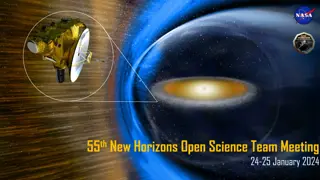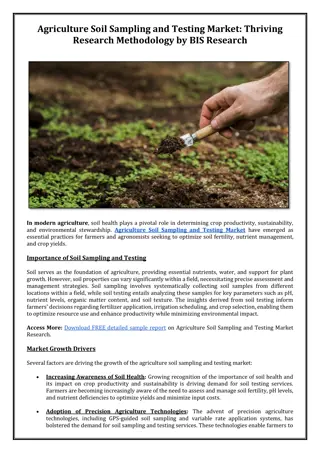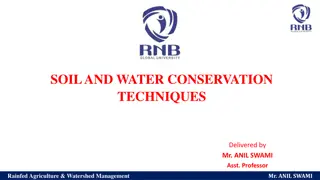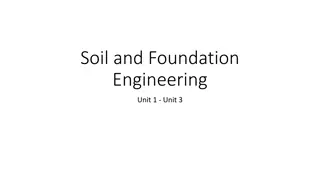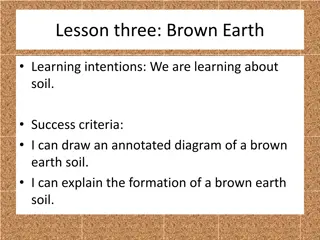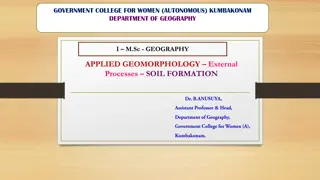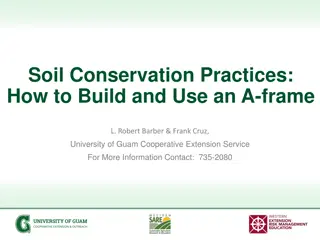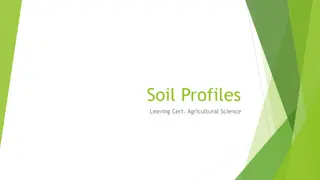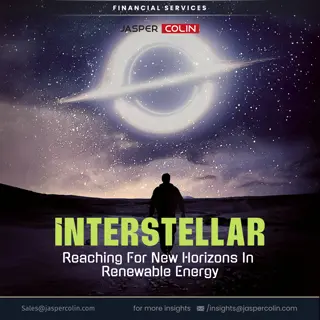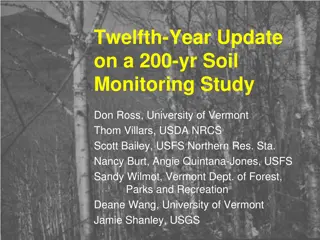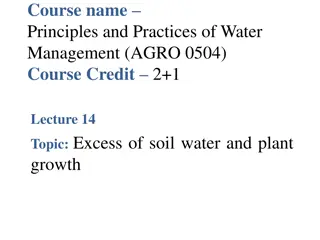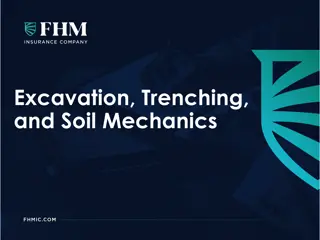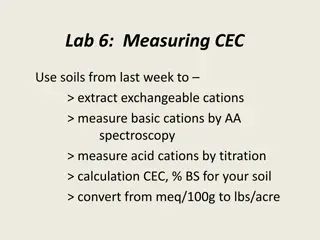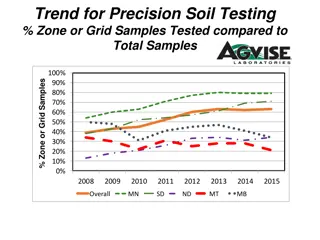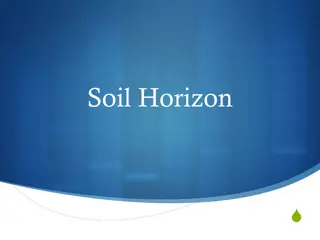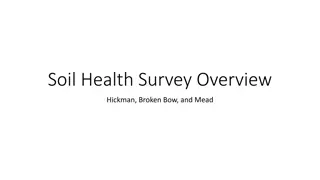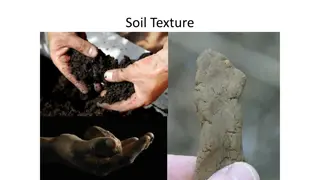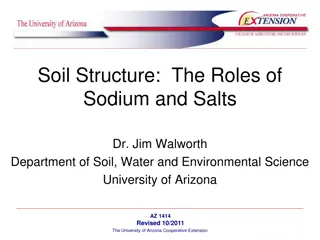Understanding Principles and Practices of Water Management in Agriculture
This course delves into the field water cycle, water movement in soil and plants, soil-plant-water relationships, water dynamics in the soil-plant-atmosphere system, soil composition, soil texture classification, permeability factors, density of soil solids, total porosity assessment, and energy asp
8 views • 62 slides
Evaluation of SPLASH and HRRR Soil Moisture Comparison
This study compares soil moisture data between the HRRR model and SPLASH observations during the 2022 warm season. It explores differences in soil moisture levels at various depths, evaluates responses to precipitation events, and drydown periods. The research focuses on analyzed data from HRRR Mode
3 views • 12 slides
Understanding Water Management: Principles, Practices, and Soil-Water Relations
Explore the principles and practices of water management in agriculture with a focus on water availability, nutrient relationships, and losses. Discover the physical classification of water, available water defined between field capacity and wilting point, soil water potential, and the soil-plant-at
6 views • 17 slides
Highlights from the 55th New Horizons Open Science Team Meeting
The 55th New Horizons Open Science Team Meeting took place on January 24-25, 2024, introducing new science team members and discussing the agenda, including team photos and breakout sessions. Rules of conduct were outlined, emphasizing professionalism. The meeting featured presentations and updates
5 views • 9 slides
Understanding the Fate of Herbicides in Soil
The fate of herbicides in soil is influenced by factors such as micro-organism decomposition, chemical decomposition, photodecomposition, adsorption by soil, surface runoff, leaching, plant uptake, and volatilization. Micro-organisms like algae, fungi, actinomyces, and bacteria play a crucial role i
6 views • 7 slides
Agriculture Soil Sampling and Testing Market: Thriving Research Methodology
In modern agriculture, soil health plays a pivotal role in determining crop productivity, sustainability, and environmental stewardship. Agriculture Soil Sampling and Testing Market have emerged as essential practices for farmers and agronomists seeking to optimize soil fertility, nutrient managemen
1 views • 2 slides
Effective Methods for Soil Conservation
Methods to reduce soil erosion and promote soil conservation include terracing, contour planting, strip cropping with cover crops, alley cropping, agroforestry, windbreaks, and conservation tillage practices such as no-till and minimum tillage. These methods help in minimizing soil erosion hotspots
1 views • 11 slides
Soil and Water Conservation Techniques in Rainfed Agriculture by Mr. Anil Swami
Explore soil erosion and various conservation techniques discussed by Mr. Anil Swami, an Assistant Professor specializing in Rainfed Agriculture and Watershed Management. Learn about prevalent soil and climatic conditions in rainfed areas, water harvesting techniques, contingent crop planning, seaso
0 views • 66 slides
Understanding the Importance of Humus in Soil Health
Humus, the organic residue in soil, plays a crucial role in soil fertility and plant growth. It improves soil structure, retains water, stores essential nutrients, and promotes microbial activity. Factors like soil fertility, moisture, temperature, and pH influence the distribution and activity of s
0 views • 21 slides
Understanding Composition of Soil Organic Matter in Soil Microbiology
Soil organic matter is vital for soil properties and plant nutrition. It consists of plant residues, animal remains, and microbial tissues, comprising complex compounds like carbohydrates, proteins, fats, and more. The composition varies with plant type, age, and nature. Leguminous plants are rich i
0 views • 19 slides
Understanding Soil and Foundation Engineering Fundamentals
Soil plays a crucial role in engineering, with unique properties that influence its mechanical behavior. This article covers the formation of soil, types including residual and transported soils, and the phases of soil in nature. Explore phase diagrams, relationships between volume, void ratio, and
0 views • 20 slides
Understanding Brown Earth Soil Formation in Temperate Broadleaved Forests
Brown Earth soils are characteristic of temperate broadleaved deciduous forests in regions like Western Europe, Russia, and North America. Deciduous trees contribute to the formation of these soils by providing a rich leaf litter that breaks down rapidly due to the mild climate. Soil organisms play
1 views • 17 slides
Understanding Soil Formation: Factors and Processes Explained
Soil formation is a complex process influenced by factors like parent material, topography, climate, organisms, and time. This article delves into the fundamentals of soil evolution, discussing how soils are formed from weathered rock materials and the role of pedogenesis. Factors affecting soil for
1 views • 28 slides
Soil Conservation Practices: Building an A-Frame for Erosion Control
Learn about the importance of soil conservation practices and how to build and utilize an A-frame tool for erosion control. Discover the causes of soil erosion and effective techniques like contour lines, contour planting, and vegetative barriers to prevent soil degradation. Find out how to construc
2 views • 14 slides
Understanding Soil Microbiology and Its Impact on Plant Growth
Soil microbiology is a branch of science that focuses on studying soil microorganisms and their activities, which play a crucial role in supporting plant life. Soil consists of organic and inorganic matter, water, and living organisms that interact in complex ways to influence plant growth and nutri
1 views • 11 slides
Soil Disinfestation Methods for Greenhouse Crop Production
Soil mixes for greenhouse production are carefully designed to optimize water retention and aeration. Proper management of artificial soil mixes can yield crops equal to those grown in topsoil. Sterilization of growing media is crucial, with techniques such as steam sterilization and fumigation comm
0 views • 11 slides
Understanding Soil Chemistry and Redox Reactions in Environmental Chemistry
Soil chemistry plays a crucial role in sustaining healthy soils by influencing nutrient availability through oxidation and reduction processes. Redox reactions in soil are impacted by factors like oxygen content and water presence, affecting nutrient supplies. The redox status of soil reflects its n
1 views • 92 slides
Understanding Soil Profiles in Agricultural Science
Soil profiles are essential for classifying soils, with main profiles being Brown Earth, Podzol, and Gley. It's crucial to draw these profiles accurately for exams, considering horizons like O Horizon, A Horizon, B Horizon, and Bedrock. Brown Earth has a thick O horizon with uniform brown color, Pod
1 views • 8 slides
Understanding the Diversity of Microorganisms in Soil Ecosystems
Microorganisms in soil play crucial roles in soil fertility, nutrient cycling, and industrial product synthesis. They can also be pathogens causing diseases in plants and humans. Soil organisms are broadly classified into two groups: soil flora and soil fauna, consisting of various microorganisms li
0 views • 57 slides
Impact Analysis of New Horizons Project: Oct 16 - Sep 19
The impact analysis of the New Horizons project from Oct 16 to Sep 19, conducted by Ann Grimsdale, reveals key insights. Participants enrolled in New Horizons exhibit higher rates of unemployment, economic inactivity, and disabilities compared to the UK population. The analysis also highlights succe
0 views • 16 slides
Soil Erosion Control and Sustainable Land Management A Guide Ensuring Sustainable Water Use for Soil Stabilization (1)
Soil erosion control and sustainable land management are crucial for preserving soil health and water resources, using stabilization and dust control for environmental protection.\n
0 views • 1 slides
Interstellar-Reaching For New Horizons In Renewable Energy
Curious to know more about how we helped transform their investment strategy and the full scope of our findings? Let\u2019s explore how we can all reach for new horizons in sustainable finance together!
2 views • 6 slides
Understanding Soil Composition and Importance
Explore the world of soil and its significance as a natural resource by discovering its composition and how it affects plant growth. Learn about the main ingredients of soil, its permeability, and the role of water, air, and organic matter. Gain insights into how soil supports plant life through lea
1 views • 30 slides
Twelfth Year Update on Soil Monitoring Study
Researchers from various institutions have been conducting a 200-year soil monitoring study since 2002 in different sites associated with the Vermont Monitoring Cooperative (VMC). The project aims to establish plots, sample at various intervals, analyze baseline values, and protect plots for future
0 views • 34 slides
Understanding Excess Soil Water and Plant Growth in Water Management
Excess soil water can lead to waterlogging, affecting plant growth negatively by creating anaerobic conditions, promoting growth of water-loving plants, hindering tillage operations, accumulating harmful salts, lowering soil temperature, and reducing crop maturity time. Preventive measures include c
0 views • 8 slides
Construction Safety and Soil Mechanics Overview
This content provides valuable information on excavation, trenching, soil mechanics, OSHA regulations, common violations in construction and excavation, fatal incidents, soil composition, and soil weight calculations. It emphasizes the importance of following safety protocols in construction work re
0 views • 45 slides
Comprehensive Soil Cation Exchange Capacity (CEC) Measurement Lab Procedure
This lab exercise focuses on measuring CEC using soil samples, extracting exchangeable cations, analyzing basic cations through AA spectroscopy, titrating acid cations, calculating CEC and base saturation percentage for the soil, and converting cation measurements from meq/100g to lbs/acre. The step
0 views • 9 slides
Understanding Soil Erosion and Conservation in 6th Grade Science
Soil erosion is the process of soil wearing away, commonly caused by natural forces like wind, water, gravity, and ice, as well as human activities such as farming, mining, and construction. Severe weather events can accelerate soil erosion. Soil conservation techniques like crop rotation, conservat
0 views • 12 slides
Soil Chemistry and Mineralogy Analysis at CSU Summer Soil Institute
Explore the comprehensive analysis of soil chemistry, texture, and mineralogy conducted at the CSU Summer Soil Institute in July 2010. The study delves into pedology, elemental composition, particle size distribution, X-ray diffractometry, and mineralogical composition of various soil samples. Detai
0 views • 22 slides
Soil Moisture Retrieval Over Bare Surfaces Using Radar Observations
This study focuses on retrieving soil moisture over bare surfaces using radar observations and a lookup table representation of forward scattering. The research aims to develop a non-empirical and simple method for accurate soil moisture retrieval without the need for ancillary information. Issues w
0 views • 14 slides
Horizon Thermodynamics of Lovelock Black Holes by David Kubiz
Gravitational dynamics and thermodynamics in Lovelock black holes are explored in this talk, discussing free energy, universal thermodynamic behavior, Lovelock gravity, and beyond spherical symmetry. References include works on black hole thermodynamics, local Rindler horizons, and apparent horizons
0 views • 25 slides
Trends in Precision Soil Testing and Average Soil Nitrate Levels (1986-2015)
This detailed content provides insights into the trends in precision soil testing, comparing zone/grid samples to total samples, and the variability of soil nitrate levels following wheat and barley crops. It includes visual representations of data from various regions and years, offering valuable i
0 views • 39 slides
Understanding Soil Horizons and Layers in Detail
Delve into the world of soil horizons with detailed descriptions of each layer - from the O Horizon containing litter and organic matter to the bedrock in the R Horizon. Explore the characteristics and functions of each layer, gaining a comprehensive understanding of soil composition and its signifi
0 views • 8 slides
Understanding Soil Characteristics and Ecosystem Interactions
This content explores various aspects of soil characteristics, including factors influencing soil thickness, the role of bedrock in soil quality, optimal soil mixtures for plant growth, the impact of living organisms on weathering, and the formation of soil. It also discusses how animals can help so
0 views • 17 slides
Understanding Soil: Formation, Composition, and Impact on Plant Growth
Soil is more than just dirt; it plays a vital role in supporting plant growth. Formed through the weathering of rocks and organic activity, soil consists of rock fragments, clay, and organic material. The process of soil formation begins with the erosion of bedrock, leading to the development of dif
0 views • 12 slides
Exploring the Fascinating World of Soil: An Insightful Journey
Delve into the intricate composition of soil through a hand lens to uncover rocks, minerals, and humus. Discover the hidden elements like water, air, and living organisms that form the foundation of soil. Witness the decomposition process by bacteria and fungi, and explore the layers of a soil profi
0 views • 15 slides
Impacts of Prescribed Burning on Soil Fertility in Mediterranean Pastures
This study investigates the effects of prescribed burning on soil fertility and carbon dynamics in Mediterranean mountain pastures. It explores how soil responds to disturbance by prescribed burning, potential legacy effects based on pre-burning conditions, and the role of local microtopography in s
0 views • 8 slides
Soil Health Survey Overview in Hickman, Broken Bow, and Mead
The Soil Health Survey Overview in Hickman, Broken Bow, and Mead reveals insights into the occupation distribution, utilization of livestock, cover crop practices, obstacles to cover crop use, and incentives driving changes to improve soil health in these regions. Farmers, landowners, and consultant
0 views • 6 slides
Understanding Soil Texture and Composition
Soil texture is defined by the proportion of sand, silt, and clay particles, with various combinations creating different textural classes. The USDA Textural Triangle helps classify soil types based on these components, with examples and descriptions provided. Coarse fragments, such as gravel, stone
0 views • 9 slides
Understanding the Role of Sodium and Salts in Soil Structure
Soil structure plays a crucial role in plant growth, water movement, and drainage. Excess sodium can cause clay particles to disperse, leading to reduced water infiltration. Flocculation, which involves cations like calcium and magnesium, helps clay particles stick together to form aggregates, impro
0 views • 29 slides



